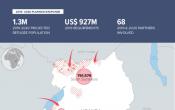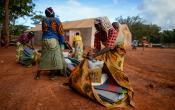Uganda
Operation: Uganda
Location
{"longitude":32,"latitude":1,"zoom_level":7,"iso_codes":"'UGA'"}
By clicking on the icons on the map, additional information is displayed.
The boundaries and names shown and the designations used on this map do not imply official endorsement or acceptance by the United Nations.
Key Figures
| 2019 year-end results | |
| 100% | of refugees (1,190,900) were able to access primary health care services. |
| 100% | preventive reproductive health and HIV services were provided, against a target of 94%. Some 7,700 refugees in settlements accessed antiretroviral therapy. |
| 73% | of registered refugee and host community children were enrolled in primary school (334,400 out of a target of 457,200). |
| 4.4 million | tree seedlings were planted, out of a National Forestry Authority target of 8.4 million (52%). |
| 4,500 | incidents of sexual and gender-based violence were reported, managed and documented. |
| 3,300 | out of a target of 4,400 individuals were submitted for resettlement (74%). |
| 0.33 | was the under-five mortality rate registered against the target of less than 1.5 per population. |
| 2020 planning figures | |
| 100% | of people of concern provided with individual protection documentation |
| 100% | of identified children of concern with specific needs assisted |
| 100% | of known sexual and gender-based violence (SGBV) survivors receive appropriate support |
| 80% | of primary school-aged children enrolled in education |
| 80% | of households with access to energy saving equipment |
Latest Updates and Related Links
People of Concern
169%
Increase in
2019
2019
| 2019 | 3,685,631 |
| 2018 | 1,370,923 |
| 2017 | 1,575,148 |

[["Refugees",1359464],["Asylum-seekers",21658],["Returned refugees",3],["Others of concern",2304506]]
Loading ...
Uganda
< Back
2019
{"categories":[2015,2016,2017,2018,2019,2020],"budget":[221.407173083,302.144587466,551.108264853,415.20307154,386.19999993,357.07001031],"expenditure":[62.65819847,125.32271148000001,204.68911788,184.59756407999998,159.58054191,null]}
{"categories":[2015,2016,2017,2018,2019,2020],"p1":[218.337173083,302.03654321600004,550.908264853,415.00307154,385.99999993,356.67001031],"p2":[0.02,0.10804425,0.2,0.2,0.2,0.4],"p3":[3.05,null,null,null,null,null],"p4":[null,null,null,null,null,null]}
{"categories":[2015,2016,2017,2018,2019,2020],"p1":[62.65402181,125.31882094,204.67148963999998,184.54791916,159.51147375,null],"p2":[0.00417666,0.00389054,0.01762824,0.049644919999999995,0.06906816,null],"p3":[null,null,null,null,null,null],"p4":[null,null,null,null,null,null]}
Loading ...
CHOOSE A YEAR
- 2014
- 2015
- 2016
- 2017
- 2018
- 2019
- 2020
Operational context
Uganda remained the largest refugee operation in Africa, hosting some 1.4 million refugees, mostly from South Sudan (861,600) and the Democratic Republic of Congo (DRC) (397,600). The vast majority of refugees lived in settlements alongside local communities, with urban centres being home to a small percentage of the refugee population, mainly in Kampala. The country continued to receive new arrivals in 2019.The protection environment in Uganda remained favorable in 2019, with Uganda’s progressive refugee policy enabling refugees to enjoy freedom of movement, the right to work and establish businesses and access to services such as health care and education.
“The National Plan of Action” to implement the Comprehesive Refugee Response Framework was updated in the first quarter of 2019 to provide direction and objectives until 2020. UNHCR’s country strategy was adjusted accordingly in order to assist the Government to include refugees in national planning and budgeting, strengthening government systems to benefit both refugees and Ugandans. UNHCR and refugees were part of the taskforce developing District Development Plans in refugee-hosting districts, with priority on education, health, environment and economic inclusion.
While the protection environment remained generally good, the Government introduced tighter security screening measures at entry points in the second half of 2019, particularly affecting arrivals from the DRC. This led to congestion at transit and reception centers, and bottlenecks in the registration process and transfers to the settlements.
In December 2019, the country experienced flooding and landslides in the Southwest, Eastern, Northern and West Nile regions. The Government appealed to the United Nations system for assistance. In response, the Central Emergency Response Fund allocated some $800,000 to UNHCR for the purchase and distribution of non-food items.
Population trends
- During 2019, some 94,725 asylum-seekers arrived in Uganda from the DRC (57,242), South Sudan (31,663) and Burundi (5,820). Women and children constituted 82%; in 2019, there were nearly 41,200 registered births in refugee communities.
- 94% of refugees lived in settlements and 6% in urban areas.
- Close to 3,300 refugees resettled to third countries.
Key achievements
- Some 23,800 cases (representing more than 47,000 individuals) were granted refugee status by the Refugee Eligibility Committee, compared to 8,000 cases in 2018.
- UNHCR launched an inter-agency feedback, referral and resolution mechanism to improve accountability to refugees and asylum-seekers.
- UNHCR supported the development, launch and implementation of Uganda’s health sector integrated refugee response plan.
Unmet needs
- The ratio of child protection caseworkers to child (1:80) remained inadequate to effectively address the needs of refugee children.
- Limited numbers of qualified psychosocial staff and partners reduced the interaction time with clients and the capacity for follow-up, and enhanced the risk of relapse and serious mental health risks.
- Only 66% latrine coverage was provided against a standard of 85%.
- An average water supply of 16.2 litres per day was provided, against a standard of 20 litres per day.
- Only 11% of secondary school-aged children were able to access formal education or vocational training.
Operational Environment
Uganda has a longstanding history of hosting refugees with more than 1.1 million refugees and asylum-seekers as of October 2018. The country has received more than 1 million refugees from the Democratic Republic of Congo and South Sudan since July 2016. These protracted situations as well as the recent influx of refugees have strained the resources of the humanitarian system and put enormous pressure on the resources of host communities and on the environment.Most refugees reside in designated refugee settlements located across 11 districts and in Kampala. The Government of Uganda allows freedom of movement and provides land to refugees settling in designated areas, the right to work and access to national services. The North and West Nile regions, where most refugees live, are among the poorest and most underdeveloped areas in the country.
Children, adolescents and youth make up the highest population bracket among the displaced populations in Uganda. Some 57 per cent of school-aged refugee children are out of school, the majority of whom are girls. Adolescents and youth account for a third of the refugee population, with the majority suffering from the lack of appropriate learning and employment opportunities. Refugee women and girls, who comprise approximately 55 per cent of the refugee population in Uganda, are at risk of heightened social and economic vulnerabilities.
Many refugees in Uganda have limited income-generating opportunities, and both refugees and host communities are challenged by the lack of access to capital/ formal financial services; lack of access to cultivable land and water; poor market connectivity; limited skills and the few formal employment opportunities.
Key Priorities
Uganda has implemented the Comprehensive Responses which further promote Uganda’s progressive policy through a multi-stakeholder approach, boosting self-reliance and expanding solutions for both refugee and host communities. UNHCR supports the Office of Prime Minister in leading and coordinating the refugee response in Uganda, along with District Local Governments. Line ministries are developing strategies and comprehensive response plans for refugee-hosting areas in education, water delivery and infrastructure, environment and energy, health-care, as well as employment and livelihoods strategy. In 2019-20 UNHCR will mobilise maximum resources to support these plans.UNHCR’s main priorities for 2019-20 will be to ensure significant expansion in education, environment and livelihoods, as well as maintain quality protection interventions and continue to strengthen accountability and risk management.



























